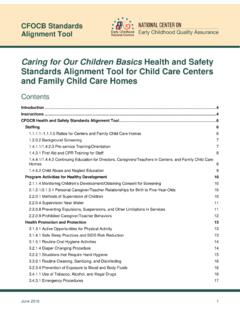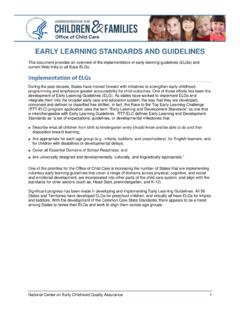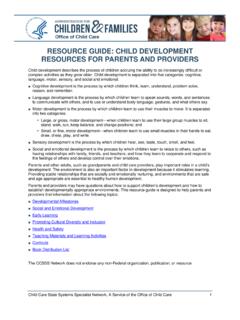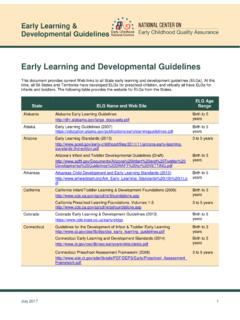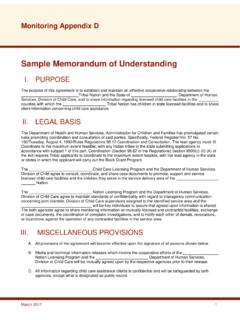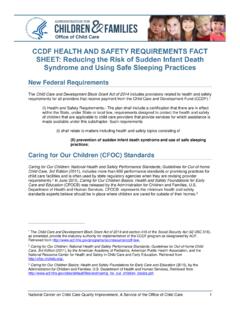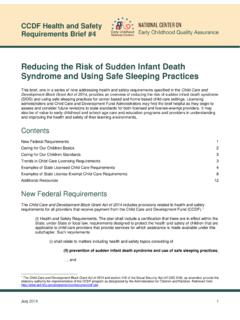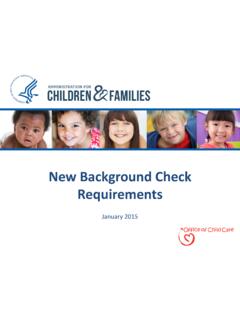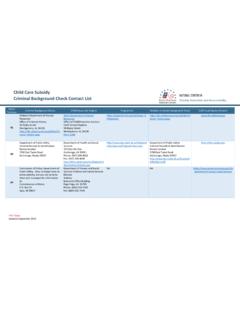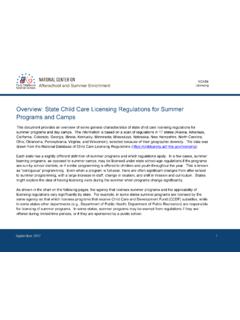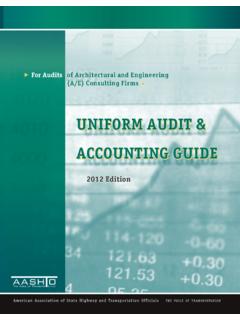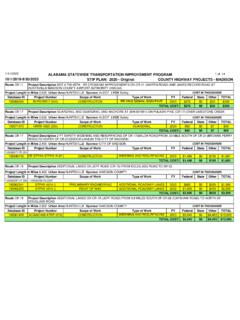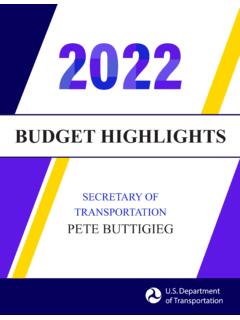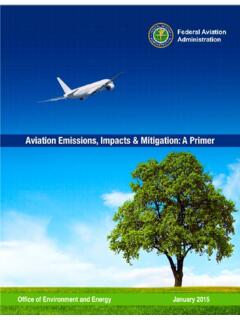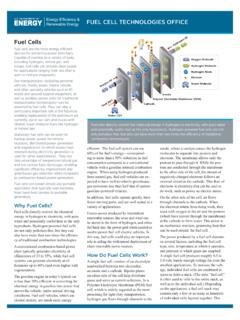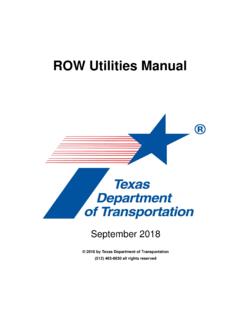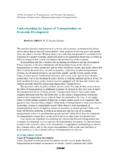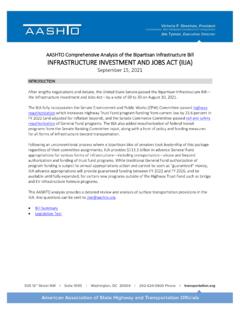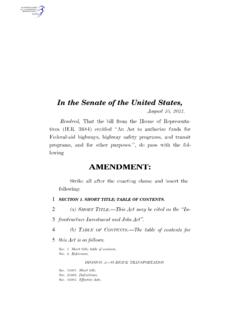Transcription of Transportation of Children - United States Department of ...
1 CCDF Health and Safety Requirements Brief #8 July 2016 1 Transportation of Children This brief, one in a series of nine addressing health and safety requirements specified in the Child Care and Development Block Grant Act of 2014, provides an overview of Transportation requirements for center-based and home-based child care settings. Licensing administrators and Child Care and Development Fund Administrators may find the brief helpful as they begin to assess and consider future revisions to state standards for both licensed and license-exempt providers. It may also be of value to early childhood and school-age care and education programs and providers in understanding and improving the health and safety of their learning environments. Contents New federal Requirements 1 Transportation Safety 2 Caring for Our Children Basics 2 Caring for Our Children Standards 4 Trends in Child Care Licensing Requirements 5 Examples of State Licensed Child Care Requirements 6 Examples of State License-Exempt Child Care Requirements 11 Additional Resources 12 New federal Requirements The Child Care and Development Block Grant Act of 2014 includes provisions related to health and safety requirements for all providers that receive payment from the Child Care and Development Fund (CCDF).
2 1 (I) Health and Safety Requirements. The plan shall include a certification that there are in effect within the State, under State or local law, requirements designed to protect the health and safety of Children that are applicable to child care providers that provide services for which assistance is made available under this subchapter. Such requirements (i) shall relate to matters including health and safety topics consisting of (IX) for providers that offer Transportation , if applicable, appropriate precautions in transporting Children ; .. and 1 The Child Care and Development Block Grant Act of 2014 and section 418 of the Social Security Act (42 USC 618), as amended, provide the statutory authority for implementation of the CCDF program as designated by the Administration for Children and Families. Retrieved from Transportation of Children July 2016 2 (XI) minimum health and safety training, to be completed pre-service or during an orientation period in addition to ongoing training, appropriate to the provider setting involved that addresses each of the requirements relating to matters described in subclauses (I) through (X).
3 Transportation Safety Keeping Children safe in a vehicle means using appropriate car seats and being sure that everyone is buckled up correctly for every ride. In 2012, all 50 States , the District of Columbia, and Puerto Rico had seat belt use laws and laws requiring Children of certain ages to be restrained in child safety But there are other dangers in and around vehicles that drivers and caregivers need to be aware of to keep Children protected. Children who are left unattended in a closed vehicle may die or be injured as a result of heatstroke or hyperthermia. Hyperthermia can occur in vehicles even if outside temperatures are mild. When the outside temperature reaches 60 to 70 degrees Fahrenheit, the inside of a vehicle can reach dangerous temperatures in as little as fifteen minutes. This rise in vehicle temperature is especially dangerous for young Children . A young child s body temperature increases three to five times faster than that of an Because of this danger, vehicles should be locked when not in use and checked after use to make sure no child is left unintentionally in a Caring for Our Children Basics Released in 2015 by the Administration for Children and Families (ACF), Caring for Our Children Basics: Health and Safety Foundations for Early Care and Education (CFOCB) represents the minimum health and safety standards experts believe should be in place where Children are cared for outside their CFOCB seeks to reduce conflicts and redundancies found in program standards linked to multiple funding streams.
4 Though voluntary, ACF hopes CFOCB will be a helpful resource for States and other entities as they work to improve health and safety standards in licensing and quality rating and improvement systems. The following standards from CFOCB address the safe Transportation of Children while in care. Qualifications for Drivers In addition to meeting the general staff background check standards, any driver or Transportation staff member who transports Children for any purpose should have: a) A valid driver's license that authorizes the driver to operate the type of vehicle being driven; b) A safe driving record for more than 5 years, with no crashes where a citation was issued, as evidenced by the state Department of Motor Vehicles records; c) No use of alcohol, drugs, or any substance that could impair abilities before or while driving; 2 National Highway Traffic Safety Administration, Department of Transportation .
5 (2014). Traffic safety facts: 2012 data. Retrieved from 3 Early Care and Learning Knowledge Center, Office of Head Start, Administration for Children and Families. (2011). Keeping Children safe in and around vehicles [Web page]. Updated 2015. Retrieved from 4 American Academy of Pediatrics, the American Public Health Association, & the National Resource Center for Health and Safety in Child Care and Early Education. (2011). Chapter 6: Play areas/playgrounds and Transportation , in Caring for our Children : National health and safety performance standards; guidelines for early care and education programs, 3rd edition. Retrieved from 5 A Administration for Children and Families, Department of Health and Human Services. (2015). Caring for our Children basics: Health and safety foundations for early care and education. Retrieved from Transportation of Children July 2016 3 d) No tobacco use while driving; e) No medical condition that would compromise driving, supervision, or evacuation capability; f) Valid pediatric CPR and first aid certificate if transporting Children alone.
6 The driver's license number and date of expiration, vehicle insurance information, and verification of current state vehicle inspection should be on file in the facility. Child Passenger Safety When Children are driven in a motor vehicle other than a bus, all Children should be transported only if they are restrained in a developmentally appropriate car safety seat, booster seat, seat belt, or harness that is suited to the child's weight and age in accordance with state and federal laws and regulations. The child should be securely fastened, according to the manufacturer's instructions. The child passenger restraint system should meet the federal motor vehicle safety standards contained in 49 CFR and carry notice of compliance. Child passenger restraint systems should be installed and used in accordance with the manufacturer's instructions and should be secured in back seats only. Car safety seats should be replaced if they have been recalled, are past the manufacturer's date of use expiration date, or have been involved in a crash that meets the Department of Transportation crash severity criteria or the manufacturer's criteria for replacement of seats after a crash.
7 If the program uses a vehicle that meets the definition of a school bus and the school bus has safety restraints, the following should apply: a) The school bus should accommodate the placement of wheelchairs with four tie-downs affixed according to the manufactures instructions in a forward-facing direction; b) The wheelchair occupant should be secured by a three-point tie restraint during transport; c) At all times, school buses should be ready to transport Children who must ride in wheelchairs; d) Manufacturers specifications should be followed to assure that safety requirements are met. Interior Temperature of Vehicles The interior of vehicles used to transport Children for field trips and out-of-program activities should be maintained at a temperature comfortable to Children . All vehicles should be locked when not in use, head counts of Children should be taken before and after transporting to prevent a child from being left in a vehicle, and Children should never be left in a vehicle unattended.
8 Passenger Vans Early care and education programs that provide Transportation for any purpose to Children , parents/guardians, staff, and others should not use 15-passenger vans when avoidable. Transportation of Children July 2016 4 Caring for Our Children Standards Caring for Our Children : National Health and Safety Performance Standards; Guidelines for Early Care and Education Programs, 3rd edition (CFOC3), is a collection of 686 national standards that represent best practices with respect to health and safety in early care and education settings. CFOC3 can help programs and providers implement CFOCB, understand rationale, and move to higher levels of quality in health and safety. CFOC3 is available at The following links to CFOC3 pertain to the Transportation of Children . The links go to the full text of each standard, which is presented alongside an explanation of its rationale, supported by research. Standard Availability and Use of a Telephone or Wireless Communication Device Standard First Aid and Emergency Supplies Standard Competence and Training of Transportation Staff Standard Qualifications for Drivers Standard Drop-Off and Pick-Up Standard Child Passenger Safety Standard Interior Temperature of Vehicles Standard Distractions While Driving 6 American Academy of Pediatrics, American Public Health Association, & National Resource Center for Health and Safety in Child Care and Early Education.
9 2011. Caring for our Children : National health and safety performance standards; Guidelines for early care and education programs. 3rd edition. Retrieved from Transportation of Children July 2016 5 Standard Passenger Vans Trends in Child Care Licensing Requirements The following tables provide information about the number of States7 with requirements related to transporting Children in their 2014 licensing regulations for child care centers,8 family child care (FCC) homes,9 and group child care (GCC) In 2014, only 13 percent of States reported that their licensed child care center regulations required training about transporting Children , and only 13 percent required child care centers to conduct an additional check for Children remaining on board vehicles after unloading. Driver and Auto Insurance Requirements Licensing Requirements Child Care Centers (N = 53) FCC Homes (N = 46) GCC Homes (N = 40) State has requirements for vehicle drivers ( , driver s license, minimum age requirements).
10 46 38 34 Facilities are required to have automobile insurance. 31 25 21 Staff or providers are required to complete training about transporting Children . 7 5 7 N = the number of States that regulate the type of facility. Supervision of Children in Vehicles Licensing Requirements Child Care Centers (N = 53) FCC Homes (N = 46) GCC Homes (N = 40) Staff or providers must provide supervision of Children when they board and exit vehicles. 24 13 17 Staff or providers must conduct additional checks for Children remaining on board once vehicles are unloaded. 7 6 6 N = the number of States that regulate the type of facility. 7 States includes the 50 States , the District of Columbia, and 2 Territories: Guam and the Virgin Islands. 8 National Center on Early Childhood Quality Assurance. (2015). Research brief #1: Trends in child care center licensing regulations and policies for 2014.
